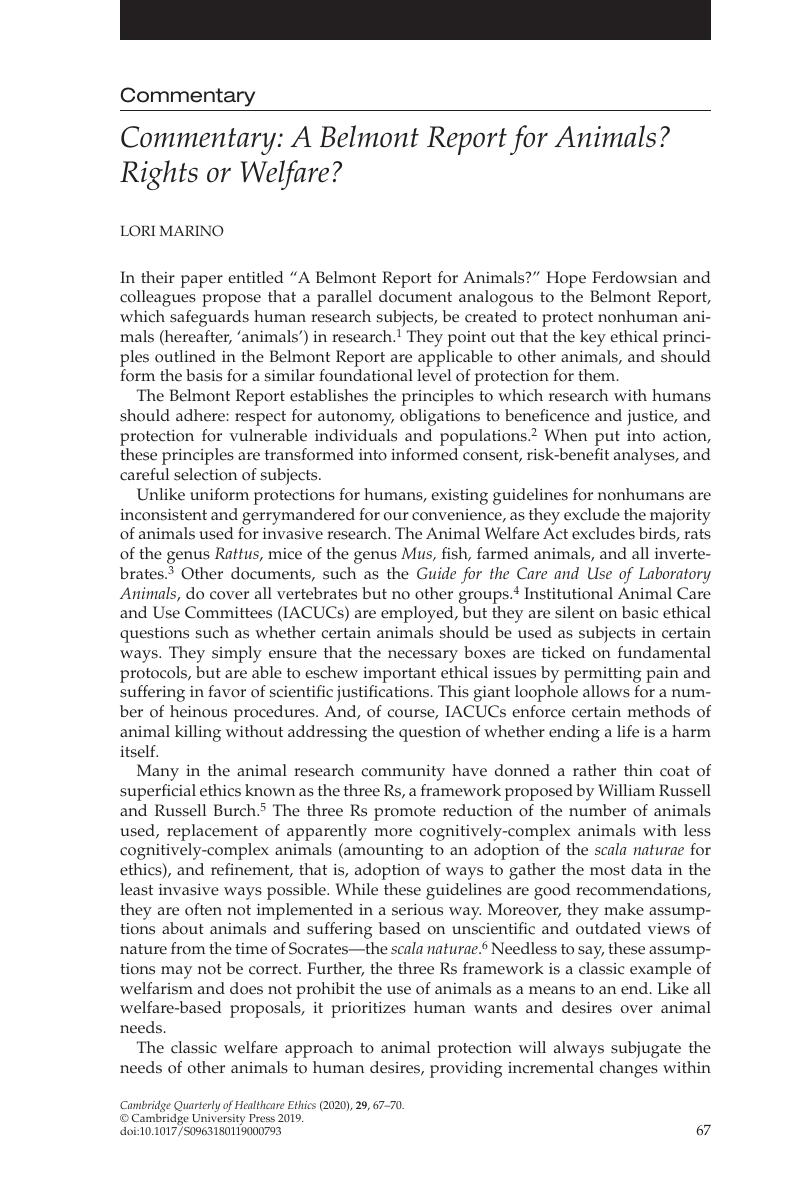Published online by Cambridge University Press: 20 December 2019

1. Ferdowsian, H, Johnson, SM, Johnson, J, Fenton, A, Shriver, A, Gluck, J. A Belmont Report for animals? Cambridge Quarterly of Healthcare Ethics 2020;29(1):19–37.CrossRefGoogle Scholar
2. National Commission for the Protection of Human Subjects of Biomedical and Behavioral Research. The Belmont Report 18 April 1979; Washington, DC: US Department of Health, and Human Services; available at https://www.hhs.gov/ohrp/regulations-and-policy/belmont-report/index.html (last accessed 18 May 2019).Google Scholar
3. 7 U.S.C. §§ 2131–2159 (1966), as amended.
4. National Research Council Committee for the Update of the Guide for the Care and Use of Laboratory Animals. Guide for the Care and Use of Laboratory Animals, 8th ed. Washington, DC: National Academies Press; 2011.Google Scholar
5. Russell, WMS, Burch, RL. The Principles of Humane Experimental Technique. London, UK: Methuen & Co., Ltd; 1959.Google Scholar
6. Marino, L. The Scala Naturae. In: Bekoff, M, ed. Encyclopedia of Human-Animal Relationships: A Global Exploration of Our Connections with Animals, Volume One. Westport, CT: Greenwood; 2007.Google Scholar
7. Marino, L. Ethical gerrymandering in science. Journal of Animal Ethics 2011;1:119–21.CrossRefGoogle Scholar
8. Marino, L. Why animal welfarism continues to fail. Animal Sentience: An Interdisciplinary Journal on Animal Feeling 2016;1(7)(5); available at https://animalstudiesrepository.org/animsent/vol1/iss7/5/ (last accessed 18 May 2019).Google Scholar
9. Wise, S. Drawing the Line: Science and the Case for Animal Rights. Cambridge, MA: Basic Books; 2003.Google Scholar
10. See the Nonhuman Rights Project; available at https://www.nonhumanrights.org/ (last accessed 18 May 2019).
11. Wise, S. Entitling non-human animals to fundamental legal rights on the basis of practical autonomy. In: Turner, J, D’Silva, J, eds. Animals, Ethics and Trade: The Challenge of Animal Sentience. New York, NY: Earthscan; 2005.Google Scholar The Nonhuman Rights Project is working to secure legal rights for some animals recognized in common law because common law is based largely on precedent, and if some other animals can be shown to have practical autonomy then there is a logical argument for legal personhood under the common law for them.
12. Andrews, K. The Animal Mind: An Introduction to the Philosophy of Animal Cognition. New York, NY: Routledge; 2015. Also seeGoogle Scholar Donaldson, S, Kymlicka, W. Zoopolis: A Political Theory of Animal Rights. Oxford, UK: Oxford University Press; 2011; andGoogle Scholar Beauchamp, T. The failure of theories of personhood. In: Thomasma, D, Weisstub, D, Hervé, C, eds. Personhood and Health Care. New York, NY: Springer, Dordrecht; 1999.Google Scholar